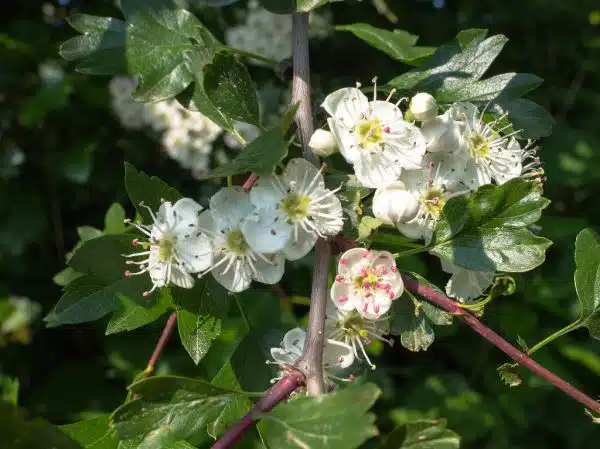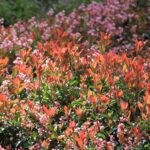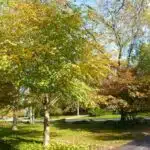The Hawthorn tree, also known as Crataegus, is a small to medium-sized deciduous tree that belongs to the rose family. This tree is native to temperate regions of Europe, Asia, and North America. It is widely known for its ornamental value and medicinal properties. The hawthorn tree has been used for centuries in herbal medicine to treat various health conditions such as heart disease, high blood pressure, and digestive problems.
As a horticulturalist or arborist, it is important to have a thorough understanding of the care and growing requirements of the Hawthorn tree. This guide will provide an overview of the different varieties of Hawthorn trees available, their ideal growing conditions, and how to care for them properly. Whether you are planting a new hawthorn tree in your garden or taking care of an existing one, this guide will equip you with the knowledge needed to keep your Hawthorn healthy and thriving for years to come.
The History Of Hawthorn Trees
Hawthorn trees, also known as thornapples or May-trees, have a rich and fascinating history that spans centuries. These trees belong to the Rosaceae family and are native to Europe, Asia, and North America. Hawthorns have been cultivated since ancient times, with evidence of their use dating back to the Greek physician Dioscorides in the first century AD.
The significance of hawthorn trees in various cultures is undeniable. In Celtic mythology, they were believed to be a gateway between worlds and were often used for protection against evil spirits. In Christian tradition, hawthorns were associated with the crown of thorns worn by Jesus Christ during his crucifixion. Due to this symbolism, hawthorns were often planted near churches and graveyards. Additionally, hawthorns have been used for medicinal purposes for centuries due to their potent antioxidant properties.
Despite their cultural significance, hawthorn trees are relatively easy to grow and care for. There are several different varieties of hawthorn trees available today, each with its own unique features and benefits. Understanding the differences between these varieties can help you choose the right tree for your specific needs and preferences. Let’s take a closer look at some of the different types of hawthorn trees available on the market today.
Different Varieties Of Hawthorn Trees
Hawthorn trees are known for their beautiful flowers and berries, which make them a popular choice in gardens and landscapes. There are several different varieties of hawthorn trees that you can choose from, each with its unique characteristics. Some of the most common varieties include the English hawthorn, the Washington hawthorn, and the cockspur hawthorn.
The English hawthorn is a small tree that is known for its dense foliage and fragrant flowers. It is a popular choice for hedgerows and can also be grown as a specimen tree in gardens. The Washington hawthorn, on the other hand, is a medium-sized tree that produces showy white flowers in spring and red berries in fall. This variety is tolerant of urban pollution and makes an excellent street tree.
When it comes to cultivating hawthorn trees, it’s important to choose the right location. Hawthorns prefer full sun but can tolerate some shade. They also need well-drained soil that is rich in organic matter. If you live in an area with heavy clay soil, consider amending it with compost or sand to improve drainage.
Moving forward into choosing the right location for your hawthorn tree, it’s important to consider factors such as soil type, moisture level, and exposure to sunlight. By taking these factors into account when planting your tree, you can ensure that it will thrive and provide beauty and enjoyment for years to come.
Choosing The Right Location For Your Hawthorn Tree
Choosing the Right Location for Your Hawthorn Tree is crucial for its survival and healthy growth. As the saying goes, “Location, location, location.” This holds true for hawthorn trees because they require a specific environment to thrive. The first step in choosing the right spot is to assess the area’s sun exposure. Hawthorns thrive in full sun but can tolerate partial shade.
Once you’ve determined the sun exposure of your chosen area, it’s time to consider soil type and water drainage. Hawthorns prefer well-draining soils that are slightly acidic with a pH range of 6.0 to 7.5. Poorly drained soils can result in root rot and other diseases that can damage or kill your tree. Additionally, proximity to other plants should be considered as hawthorns do not like competition from other plants.
When selecting a location for your hawthorn tree, there are a few things to keep in mind to ensure its success. Proper sun exposure, soil type and water drainage, and avoiding crowding from other plants are essential factors that will contribute greatly to your hawthorn’s overall health and longevity. In the next section, we will discuss soil requirements for healthy growth, which is another critical aspect of caring for your hawthorn tree.
Soil Requirements For Healthy Growth
- The soil fertility of an area is an important factor when considering the health and growth of a hawthorn tree.
- Adequate drainage is required to ensure that the soil holds enough moisture for the tree but not too much, as this can lead to root rot.
- The pH balance of the soil should be around 6.5 to 7.0, as this is the range for optimal growth for hawthorns.
- Regular watering is necessary for the hawthorn tree in order to maintain balance in the soil and to promote healthy growth.
- The soil should be aerated regularly to help with drainage, as compacted soils can lead to shallow root systems.
- Fertilizer should be applied to the soil annually to provide essential nutrients for the tree, such as nitrogen and potassium.
Soil Fertility
Maintaining the soil fertility is a crucial aspect of growing a healthy hawthorn tree. One way to ensure that the soil is healthy enough to sustain your tree is through soil testing. The test will help you know the nutrient content and pH level of the soil, which will guide you in making necessary adjustments to maintain an optimal growing environment for your hawthorn tree.
A common challenge faced by many gardeners or farmers is nutrient deficiencies in their soils. Different nutrients are required in varying amounts for proper plant growth, and when lacking, they can cause stunted or yellowing leaves, poor fruiting or flowering, among other issues. To avoid this problem, it’s essential to understand the nutrient requirements of your hawthorn tree and supplement them as needed.
Soil fertility plays a significant role in ensuring that your hawthorn tree thrives. Regularly testing your soil and addressing any nutrient deficiencies will go a long way towards promoting optimal growth and ensuring that your tree stays healthy for years to come. Remember, maintaining an ideal growing environment requires continuous effort and attention to detail.
Watering Needs
As a horticulturalist or arborist, it’s essential to understand the watering needs of your hawthorn tree. Water is an essential factor in plant growth, but too much or too little can be detrimental to your tree’s health. To ensure that your hawthorn tree thrives, you need to pay close attention to its watering frequency and soil moisture levels.
The watering frequency for your hawthorn tree will depend on various factors such as weather conditions, soil type, and the age of the tree. Young trees require more water than mature ones, and during hot and dry weather conditions, you may need to water more often. However, overwatering can lead to waterlogging and root rot, which can quickly kill your tree. It’s crucial to monitor the soil moisture levels regularly and only water when necessary.
To maintain optimal soil moisture levels for your hawthorn tree, you need to ensure that the soil retains enough moisture without becoming too wet or too dry. One way to achieve this is by applying a layer of mulch around the base of the tree. Mulch helps to retain soil moisture by reducing evaporation from the soil surface while also regulating soil temperature. You can also incorporate organic matter into the soil to improve water-holding capacity and promote healthy root growth.
In conclusion, understanding the watering needs of your hawthorn tree is essential for maintaining healthy growth. By monitoring the watering frequency and soil moisture levels while incorporating appropriate techniques like mulching and organic matter incorporation into your care routine, you can ensure that your hawthorn tree remains healthy and produces quality fruit or flowers for years to come.
Ph Balance
Maintaining the optimal soil conditions is crucial for the healthy growth of your hawthorn tree. Soil testing is an essential step in determining the pH balance of your soil. The pH level measures the acidity or alkalinity of the soil, which affects nutrient availability to plants. Hawthorn trees prefer a slightly acidic to neutral soil pH level ranging from 6.0 to 7.5.
If your soil’s pH level falls outside the ideal range, it can affect your hawthorn tree’s growth and development. A high soil pH level can cause nutrient deficiencies, while a low pH level can lead to toxic levels of elements like aluminum and manganese. Adjusting your soil’s pH level is necessary if it falls outside the recommended range.
To adjust your soil’s pH level, you can add amendments like lime to increase alkalinity or sulfur to lower acidity levels. The amount of amendment required depends on the current pH level and desired adjustment. It’s crucial to follow recommended application rates and guidelines to avoid overapplication, leading to further imbalances in your soil.
Maintaining an optimal soil pH balance is just as important as watering frequency and moisture levels for healthy hawthorn tree growth. Regularly testing and adjusting your soil’s pH levels will ensure that your tree has access to essential nutrients for robust growth while avoiding potential toxicity issues caused by imbalanced soils.
Watering And Fertilizing Your Hawthorn Tree
A healthy hawthorn tree requires proper watering and fertilization. While soil requirements are crucial for healthy growth, it is equally important to ensure that your tree receives consistent moisture and nutrients. Watering your tree regularly can help it withstand periods of drought and stress. Proper fertilization can also enhance the plant’s resistance to pests and diseases.
When it comes to watering your hawthorn tree, consistency is key. The frequency of watering will depend on various factors such as climate, soil type, and season. However, as a general rule of thumb, a newly planted hawthorn should be watered at least once a week during its first growing season. As the tree matures, you can gradually reduce the frequency of watering to once every two weeks or so. Be sure not to overwater your tree as this can lead to root rot.
Fertilizing your hawthorn with organic materials such as compost or manure can provide essential nutrients without harming the environment. Organic fertilizers are slow-release which means they release nutrients gradually over time instead of all at once like synthetic fertilizers do. This ensures that the roots have access to nutrients consistently throughout the growing season and reduces the risk of fertilizer burn. Consider applying organic fertilizers in early spring before new growth appears or in fall after leaves have fallen.
Next up we’ll discuss pruning and shaping tips that can help keep your hawthorn healthy and looking its best year-round.
Pruning And Shaping Tips
Pruning timing for a hawthorn tree should be done during the dormant season, typically at the end of winter or beginning of spring. Pruning should aim to remove dead, diseased and crossing branches, as well as thinning out the canopy to promote air circulation. Additionally, pruning should be done in a way that preserves the natural shape of the tree. When shaping a hawthorn tree, consider the placement of branches in order to create a pleasing aesthetic. Cuts should be made at a 45-degree angle, just before a bud, and cuts should be made in a way that avoids leaving stubs. Finally, it is important to use the appropriate tools to avoid damaging the tree and ensure a successful pruning and shaping job.
Pruning Timing
Pruning is a crucial part of maintaining the health and aesthetic appeal of hawthorn trees. Timing is a key factor in ensuring successful pruning. For hawthorn trees, spring and winter pruning are recommended.
Spring pruning should be done before the tree begins to bloom. This timing allows for better visibility of the tree’s structure and facilitates easier access to the branches. It also minimizes stress on the tree by allowing it to heal quickly after pruning. Spring pruning is ideal for removing dead or diseased wood, as well as shaping the tree for desired growth.
Winter pruning is another option for hawthorn trees. This timing allows for more drastic pruning without causing undue stress on the tree since it is dormant during this time. Winter pruning is especially useful in removing large branches or structurally unsound parts of the tree. However, care should be taken not to prune too much at once, as this can weaken the tree’s overall health.
In conclusion, proper timing of pruning is essential to maintaining healthy and attractive hawthorn trees. Spring and winter are both viable options for pruning, with each having its own advantages depending on the needs of the specific tree being pruned. As a horticulturist or arborist, it is important to consider all factors when deciding on a particular timing for pruning hawthorn trees.
Pruning Techniques
Pruning and shaping are essential components of tree maintenance. Proper pruning techniques ensure that the tree remains healthy and attractive while also promoting new growth. One of the key factors in achieving optimal results is knowing when to prune, as discussed in the previous subtopic. Another important aspect is the technique used during pruning.
Pruning frequency depends on the type of tree and its growth rate. For hawthorn trees, pruning should be done every 2-3 years to maintain their shape and health. However, it is important to note that excessive pruning can have adverse effects on the tree’s overall health. When it comes to pruning tools, a sharp pair of shears or saws are necessary for making clean cuts without damaging the bark or inner layers of the tree.
There are several techniques for pruning hawthorn trees, including thinning, heading back, and pollarding. Thinning involves removing entire branches from the tree’s canopy to allow for better light penetration and airflow. Heading back involves cutting back a portion of a branch to promote new growth. Pollarding is a more drastic form of pruning where all branches are cut back to a designated point on the trunk or main scaffold limbs. The choice of technique depends on the desired outcome and overall health of the tree.
Shaping Strategies
Pruning and shaping are crucial for maintaining the health and aesthetics of trees. While pruning focuses on removing dead or damaged branches, shaping involves creating a desired form in a tree through careful pruning techniques. Artistic pruning is one such technique that involves sculpting trees into various shapes, including geometric patterns or animal forms. The ultimate goal of artistic pruning is to enhance the beauty of the tree while also ensuring its longevity.
Natural shaping is another strategy for tree maintenance that aims to mimic nature’s natural growth patterns. This technique involves selectively pruning branches to create an open canopy that allows for better light penetration and airflow, promoting healthy growth. Natural shaping can also involve training young trees to grow in a specific direction by staking or tying them to support structures.
When it comes to shaping strategies, it is important to consider the type of tree and its growth rate. Some species require more frequent shaping than others, while some may not require any at all. Additionally, the chosen shape should complement the surrounding landscape and architecture while also considering any potential hazards such as power lines or buildings. Overall, proper shaping techniques can enhance the beauty and health of trees, making them valuable assets in any landscape design plan.
Common Pests And Diseases To Watch Out For
Despite its hardiness, the hawthorn tree is not immune to pests and diseases. Some of the common pests that can attack hawthorn trees include aphids, spider mites, and scales. These insects feed on the leaves of the tree, causing them to turn yellow or brown and eventually fall off. To prevent these pests from infesting your tree, it’s essential to keep the area around it clean by removing dead leaves and debris regularly.
Hawthorn trees are also susceptible to a range of diseases such as fire blight, leaf spot, and powdery mildew. Fire blight is a bacterial disease that causes blackened leaves and twigs while leaf spot causes brown or black spots on the leaves. Powdery mildew is a fungal disease that appears as a white powder on the leaves of the tree. To prevent these diseases from affecting your tree, make sure you prune it regularly to improve air circulation and avoid overwatering.
Prevention methods are crucial in maintaining healthy hawthorn trees. However, if your tree is already infected with pests or diseases, there are natural remedies you can try before resorting to chemical solutions. For example, spraying neem oil on your tree can help repel aphids and spider mites while using insecticidal soap can help control scales. Copper fungicide can also be used to treat fungal diseases such as powdery mildew. By using natural remedies first, you’re not only protecting your hawthorn tree but also promoting environmental sustainability.
Transition: Now that we’ve discussed how to protect your hawthorn trees from pests and diseases let’s move on to another important topic – harvesting and using hawthorn berries.
Harvesting And Using Hawthorn Berries
One interesting statistic to consider is that hawthorn berries have been used for medicinal purposes for centuries. The berries are high in antioxidants and flavonoids, which are believed to have numerous health benefits, including promoting cardiovascular health and easing digestive issues. In fact, hawthorn berry tea has been used traditionally as a natural treatment for high blood pressure.
Aside from their medicinal uses, hawthorn berries can also be incorporated into various recipes. For example, they can be used to make jams, jellies, and syrups. They can also be dried and added to teas or used in baking. One popular recipe is hawthorn berry ketchup, which is a tangy condiment that pairs well with meats and vegetables.
If you’re interested in harvesting hawthorn berries for either medicinal or culinary purposes, it’s important to do so safely and responsibly. Be sure to only harvest from trees that haven’t been treated with pesticides or herbicides. It’s also important not to take more than one-third of the tree’s berries at one time in order to ensure the tree continues to thrive.
Incorporating hawthorn berries into your diet can help improve your overall health and wellbeing. From flavorful recipes like hawthorn berry ketchup to traditional remedies like tea, there are many ways to enjoy the benefits of this versatile fruit. In the next section, we will explore propagation techniques for growing new trees so you can continue harvesting these nutrient-rich berries for years to come.
Propagation Techniques For Growing New Trees
There are two primary propagation techniques that can be used to grow new hawthorn trees. The first technique is air layering, which involves making a small incision in the bark of a mature hawthorn tree and wrapping it with moist sphagnum moss. The moss will encourage the growth of roots from the incision, which can then be cut away and transplanted into soil once they have developed sufficiently. This technique is best done in early spring or late summer when the tree is actively growing.
The second propagation technique is grafting, which involves taking a cutting from the desired variety of hawthorn tree and attaching it to an existing rootstock. This technique allows for more control over the characteristics of the resulting tree, as only a portion of it will come from the original rootstock. Grafting can be done in either late winter or early spring when the plant is dormant.
When choosing which propagation method to use, consider factors such as timing, availability of materials, and desired outcome. Both air layering and grafting techniques can be successful if done correctly, but it’s important to research each method thoroughly before attempting either one.
Markdown list:
- Air layering: Making an incision in mature hawthorn tree bark and wrapping with moist sphagnum moss
- Grafting: Taking a cutting from desired variety and attaching it to existing rootstock
- Consider factors such as timing, material availability, and desired outcome when choosing a propagation method
Transition:
Understanding how to propagate hawthorn trees is important for both hobbyist growers and professionals alike. However, even with proper care and attention during propagation there are common issues that can arise with these trees. In the subsequent section we will discuss troubleshooting tips for some of these common problems that may arise while growing your hawthorn tree.
Troubleshooting Common Issues With Hawthorn Trees
Just as a chef needs the right ingredients to prepare a delicious meal, hawthorn trees require proper nutrients and care to flourish. Even with the best intentions, however, hawthorn trees can still fall prey to pests and nutrient deficiencies. As a responsible gardener or arborist, it’s important to be able to identify these issues and take steps to address them promptly.
One of the most common problems that hawthorn trees face is pest infestations. Some of the most frequent culprits include aphids, spider mites, and scale insects. Signs of pest damage may include yellowing leaves, stunted growth, and curled or distorted foliage. If you suspect a pest problem in your hawthorn tree, there are several options for addressing it. Insecticidal soap or neem oil can be effective against many types of pests, but it’s important to avoid using harsh chemicals that could harm beneficial insects like bees.
In addition to pest control measures, it’s also crucial to ensure that your hawthorn tree has access to adequate nutrients. Common nutrient deficiencies in hawthorns include nitrogen deficiency (indicated by yellowing leaves), iron deficiency (indicated by yellowing between leaf veins), and magnesium deficiency (indicated by yellowing at leaf tips). To address these issues, you may need to amend the soil with appropriate fertilizers or use foliar sprays. With proper care and attention, your hawthorn tree can remain healthy and vibrant for years to come!
Conclusion
The hawthorn tree has a rich history and continues to be a popular choice for those who appreciate its beauty and useful properties. With various varieties available, it’s important to choose the right location that provides adequate sunlight and proper soil conditions. Regular watering and fertilizing will keep your hawthorn tree healthy and thriving, while also warding off common pests and diseases.
One of the most exciting aspects of growing a hawthorn tree is the opportunity to harvest its berries, which have been used for centuries in traditional medicine for their potential health benefits. Propagation techniques can also be used to grow new trees or share cuttings with others.
Overall, caring for a hawthorn tree requires patience and attention to detail, but the rewards are well worth it. As a horticulturalist or arborist, I encourage anyone interested in adding this beautiful tree to their landscape to do so with care and respect, keeping in mind the rich history and traditions associated with this remarkable species. In the words of William Shakespeare, “Though she be but little, she is fierce,” reminding us that even small trees can have great impact on our environment and our lives.
Image Credits
- “Hawthorn in Spring” by enneafive (featured)





























